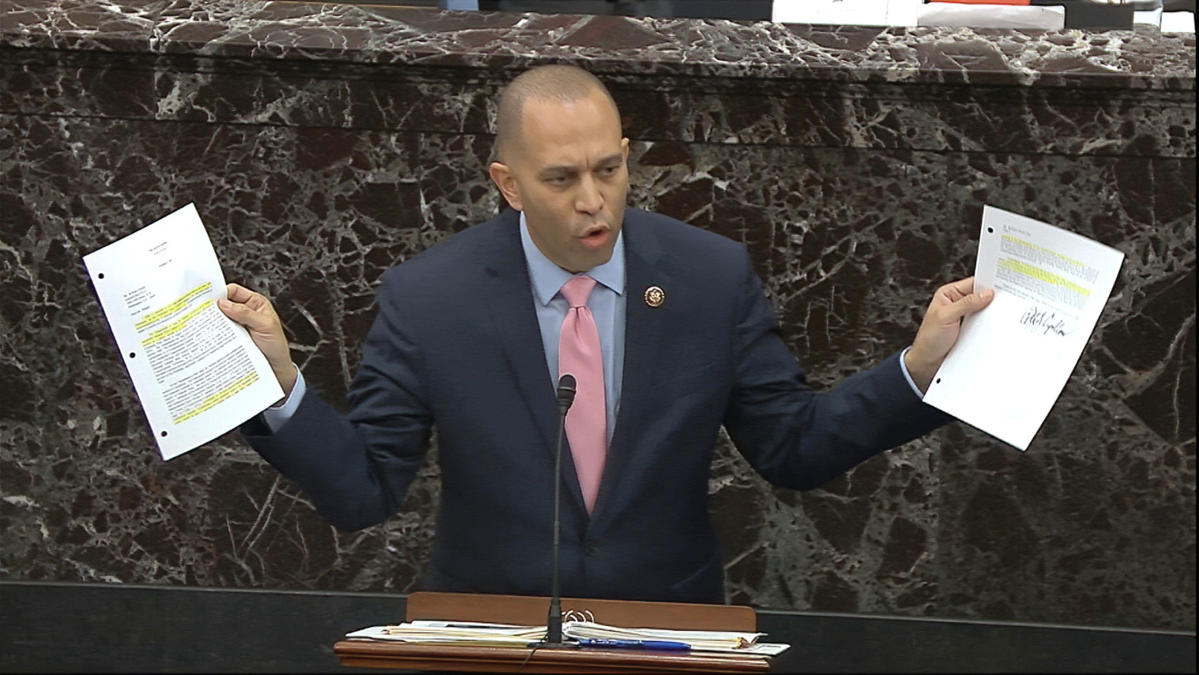(Bloomberg) — Wall Street traders sent stocks and bonds sliding after another hotter-than-estimated inflation report signaled the Federal Reserve will be in no rush to cut interest rates this year.
Most Read from Bloomberg
Equities extended their April losses, with the S&P 500 down about 1% as the consumer price index topped forecasts for a third month. Treasury 10-year yields hit the 4.5% mark that some investors are watching as a threshold that could determine whether rates will revisit the 2023 highs. Amid the hawkish repricing in the bond market, Fed swaps are now showing bets on only two rate cuts this year.
As the Fed rides the so-called last mile toward its 2% inflation goal, investors’ concern is that the recent price pressures may not be just a “blip” or a “bump in the road” — with the world’s largest economy roaring. For a data-dependent central bank, that means the higher-for-longer rates narrative taking hold again.
“It’s often said that the Fed takes the escalator up and the elevator down when setting rates,” said Richard Flynn at Charles Schwab. “But for the path downwards in this cycle, it looks like they will opt for the stairs.”
The S&P 500 dropped to around 5,150. Treasury two-year yields, which are more sensitive to imminent Fed moves, surged 18 basis points to 4.93%. The dollar headed toward its biggest advance since January.
The March core consumer price index, which excludes food and energy costs, increased 0.4% from February, according to government data out Wednesday. From a year ago, it advanced 3.8%, holding steady from the prior month.
“Inflation right now is like the stubborn child that refuses to heed the parent’s call to leave the playground,” said Jason Pride at Glenmede. “Two cuts is now likely the base case for 2024. As a result, investors should be prepared for a higher-for-longer monetary regime.”
That doesn’t mean rates are going higher — but the distance to a rate cut is another quarter, according to Jamie Cox at Harris Financial Group.
“You can kiss a June interest-rate cut goodbye,” said Greg McBride at Bankrate. “There is no improvement here, we’re moving in the wrong direction.”
To Neil Dutta at Renaissance Macro Research, Fed officials are still cutting this year, but they won’t be starting in June.
“I think July is probable, which means two cuts remain a reasonable baseline,” Dutta said. “If the Fed does not get a cut off in July, however, investors will need to worry about path dependency. As an example, would September be too close to the election? If not June, then July. If not July, then December.”
At the start of the year, the amount of easing priced in for 2024 exceeded 150 basis points. That expectation was based on the view that the US economy would slow in response to the Fed’s 11 rate hikes over the past two years. Rather, growth data has broadly exceeded expectations.
“Easy financial conditions continue to provide a significant tailwind to growth and inflation. As a result, the Fed is not done fighting inflation and rates will stay higher for longer,” said Torsten Slok at Apollo Global Management. “We are sticking to our view that the Fed will not cut rates in 2024.”
Another hot CPI reading may have been “the final nail in the coffin” for a June rate cut, but it remains to be seen whether 2024 will turn out to be a two-cut year, or something less, according to Chris Larkin at E*Trade from Morgan Stanley.
To Chris Zaccarelli at Independent Advisor Alliance, the Fed still has a bias to cut rates and is likely to do so in either July or September. Still, if inflation remains sticky, that may be the only rate cut we get this year.
“Goldilocks has left the building – inflation isn’t coming down anymore and rate-cut hopes are going to be pushed off even further into the future,” he added.
Wall Street’s Reaction to CPI Data:
That’s the sound of the door slamming shut on a June rate cut.
The Fed’s last mile just got longer and bumpier. The Fed may still be able to cut in June, but the narrative is getting increasingly difficult.
No matter how you slice the data, it’s hard to argue that inflation is falling. For a central bank that was looking for any sign that inflation was continuing to fall toward its target, this report will be a big disappointment for the Federal Reserve.
The battle between the sticky vs continued disinflationary narratives is moving decidedly toward an inflation backdrop that is plateauing and potentially accelerating. This inflation release effectively takes June off the table for the first rate cut and should push the odds out further with a coin toss in July or September.
This reinforces our view that the market remains too optimistic on rate cuts this year given the underlying strength of the US economy.
For the June rate cut optimists, this reading is a bit of blow. Markets have been wrestling with the likelihood of the Federal Reserve delivering on three rate cuts this year, but on these numbers, two rate cuts may now be the more likely outcome.
The US economy is running along at quite a pace and a June rate cut looks less and less likely – July or September is the call now. The Fed has got some head scratching to do and if other central banks were waiting for the Fed to move, they have got a conundrum on their hands now.
The rates market needs to seriously consider the likelihood of higher-for-longer at minimum lasting through the Summer and potentially through the end of the year. This number did not eclipse the Fed’s confidence, it did, however, cast a shadow on it.
This marks the third consecutive strong reading and means that the stalled disinflationary narrative can no longer be called a blip. In fact, even if inflation were to cool next month to a more comfortable reading, there is likely sufficient caution within the Fed now to mean that a July cut may also be a stretch.
Corporate Highlights:
-
Delta Air Lines Inc. expects earnings to exceed Wall Street’s projections for the second quarter as the carrier benefits from a step-up in corporate travel and steady leisure demand heading into summer.
-
Macy’s Inc. named two new directors nominated by activist investor Arkhouse Management Co., which agreed to end its effort to seek majority board representation as it attempts to acquire the department-store operator.
-
Apple Inc. assembled $14 billion of iPhones in India last fiscal year, doubling production in a sign it’s accelerating a push to diversify beyond China.
-
Taiwan Semiconductor Manufacturing Co.’s quarterly revenue grew at its fastest pace in more than a year, shoring up expectations that a global boom in AI development is fueling demand for high-end chips and servers.
-
UBS Group AG faces a “substantial” increase in regulatory capital requirements under reforms that the Swiss government is advocating for in the wake of the collapse of Credit Suisse.
-
KKR & Co. laid out a plan to scale its core businesses as it aims to reach at least $1 trillion of assets under management in five years.
Key events this week:
-
China PPI, CPI, Thursday
-
Eurozone ECB rate decision, Thursday
-
US initial jobless claims, PPI, Thursday
-
New York Fed President John Williams speaks, Thursday
-
Boston Fed President Susan Collins speaks, Thursday
-
China trade, Friday
-
US University of Michigan consumer sentiment, Friday
-
Citigroup, JPMorgan and Wells Fargo due to report results, Friday.
-
San Francisco Fed President Mary Daly speaks, Friday
Some of the main moves in markets:
Stocks
-
The S&P 500 fell 1% as of 11:08 a.m. New York time
-
The Nasdaq 100 fell 1.1%
-
The Dow Jones Industrial Average fell 1.1%
-
The Stoxx Europe 600 rose 0.1%
-
The MSCI World index fell 0.9%
Currencies
-
The Bloomberg Dollar Spot Index rose 0.8%
-
The euro fell 1% to $1.0748
-
The British pound fell 1% to $1.2555
-
The Japanese yen fell 0.7% to 152.83 per dollar
Cryptocurrencies
-
Bitcoin fell 0.9% to $68,478.38
-
Ether fell 1.1% to $3,472.58
Bonds
-
The yield on 10-year Treasuries advanced 13 basis points to 4.49%
-
Germany’s 10-year yield advanced six basis points to 2.43%
-
Britain’s 10-year yield advanced 10 basis points to 4.13%
Commodities
-
West Texas Intermediate crude fell 0.5% to $84.78 a barrel
-
Spot gold fell 0.6% to $2,337.95 an ounce
This story was produced with the assistance of Bloomberg Automation.
–With assistance from Felice Maranz and Liz Capo McCormick.
Most Read from Bloomberg Businessweek
©2024 Bloomberg L.P.

Jessica Roberts is a seasoned business writer who deciphers the intricacies of the corporate world. With a focus on finance and entrepreneurship, she provides readers with valuable insights into market trends, startup innovations, and economic developments.







